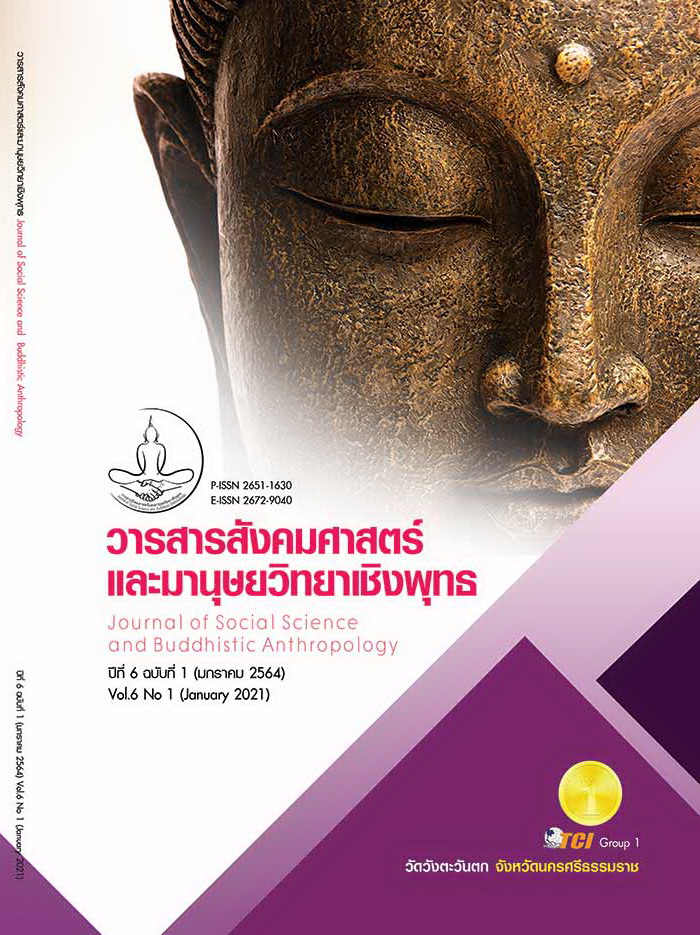THE POTENTIAL MODEL FOR HUMAN RESOURCE BUSINESS PARTNER EXECUTIVES
Keywords:
Potential Model, Human Resource Executive, Business Partner, Industrial BusinessAbstract
The Objectives of this research article were to 1) study the components of the human resource business partner executives and 2) to develop a potential model for human resource business partner executives. The research method of this study is the mixed method. Qualitative research method was in-depth interviews of eight experts with ten years experience in human resource sectors including chief executive, human resource executive and human resource experts from organization that has been awarded the excellence establishment model award in industrial business and human resources development with semi-structure in-depth interview form, and focus group with fourteen experts with ten years experience in industrial business and human resources for evaluate model. Quantitative research method was gathered data from the 505 sample including supervisor, first-line manager, middle manager, top manager and business owners with developed questionnaire and analyzed by the arithmetic mean, the standard deviation, and the exploratory factor analysis. The results revealed that 1) study the components of the human resource business partner executives can be classified into three dimension seventy-seven components which are 1.1) Knowledge and ability in business administration 11 components 1.2) Strategic operations 41 components and 1.3) Collaboration in the enterprise 25 components. And 2) a potential model for human resource business partner executives after analysis with the exploratory factor analysis can be classified into three dimensions nine components which are 2.1) Knowledge and ability in business administration 2 components 2.2) Strategic operations 4 components and 2.3) Collaboration in the enterprise 3 components.
References
กระทรวงการท่องเที่ยวและกีฬา. (2561). สถิตินักท่องเที่ยว. เรียกใช้เมื่อ 15 มกราคม 2562 จาก https://www.mots.go.th/more_news_new.php?cid=411
กระทรวงอุตสาหกรรม. (2561). สถิติอุตสาหกรรม. เรียกใช้เมื่อ 15 มกราคม 2562 จาก http://statbbi.nso.go.th/staticreport/page/sector/th/12.aspx
ชญาภัทร์ กี่อาริโย และคณะ. (2559). รูปแบบการพัฒนาศักยภาพผู้ประกอบการวิสาหกิจชุมชนในกลุ่มจังหวัดภาคกลาง. วารสารวิชาการพระจอมเกล้าพระนครเหนือ, 26(1), 141-152.
ดวงกมล ปุณยนิธิ. (2557). บทบาทหน้าที่ของฝ่ายทรัพยากรมนุษย์ในฐานะหุ้นส่วน (Business Partner) ในองค์การธุรกิจ กรณีศึกษา: ธนาคารพาณิชย์แห่งหนึ่ง. ใน รายงานการวิจัย. มหาวิทยาลัยธรรมศาสตร์.
ธีจุฑา ประสาทแก้ว และคณะ. (2562). การพัฒนารูปแบบศักยภาพผู้บริหารระดับกลางเพื่อการแข่งขันในธุรกิจอุตสาหกรรมการบิน. เรียกใช้เมื่อ 2562 มกราคม 2562 จาก http://ojs.kmutnb.ac.th/index.php/kjournal/article/download/2336/2011
ธีรวัช บุณยโสภณ. (2558). แนวคิดในการพัฒนาธุรกิจอุตสาหกรรมให้มีประสิทธิภาพ. วารสารวิชาการพระจอมเกล้าพระนครเหนือ, 25(2), 325-336.
ปริยสุทธิ์ วัฒนธรรม และคณะ. (2562). รูปแบบการพัฒนาศักยภาพผู้ควบคุมคุณภาพการผลิตหม้อน้ำอุตสาหกรรม. วารสารวิชาการพระจอมเกล้าพระนครเหนือ, 29(4), 711-722.
ปัญญา พิมพขันธ์ และคณะ. (2563). รูปแบบการพัฒนาศักยภาพนักพัฒนาผลิตภัณฑ์ในอุตสาหกรรมอิเล็กทรอนิกส์. วารสารวิชาการพระจอมเกล้าพระนครเหนือ, 30(3), 537-546.
ปาหนัน เทศบรรทัด และคณะ. (2563). รูปแบบการพัฒนาศักยภาพของผู้บริหารระดับกลางในอุตสาหกรรม ปิโตรเคมี. วารสารวิชาการพระจอมเกล้าพระนครเหนือ, 30(3), 529-536.
ปิยพจน์ ตุลาชม และคณะ. (2557). รูปแบบการพัฒนาคุณลักษณะผู้บริหารมืออาชีพของผู้บริหารสถานศึกษาระดับมัธยมศึกษา. วารสารบัณฑิตศึกษา มหาวิทยาลัยราชภัฏสกลนคร, 11(53), 173-178.
ผู้ให้ข้อมูลหลัก Exp1. (2563). บทบาท ความสำคัญ ปัจจัยหลักที่มีผลต่อการพัฒนา และแนวทางการพัฒนาศักยภาพของผู้บริหารทรัพยากรมนุษย์. (ปัณฎารีย์ กิ่งวงศา, ผู้สัมภาษณ์)
ผู้ให้ข้อมูลหลัก Exp2. (2563). บทบาท ความสำคัญ ปัจจัยหลักที่มีผลต่อการพัฒนา และแนวทางการพัฒนาศักยภาพของผู้บริหารทรัพยากรมนุษย์. (ปัณฎารีย์ กิ่งวงศา, ผู้สัมภาษณ์)
ผู้ให้ข้อมูลหลัก Exp4. (2563). บทบาท ความสำคัญ ปัจจัยหลักที่มีผลต่อการพัฒนา และแนวทางการพัฒนาศักยภาพของผู้บริหารทรัพยากรมนุษย์. (ปัณฎารีย์ กิ่งวงศา, ผู้สัมภาษณ์)
ผู้ให้ข้อมูลหลัก Exp8. (2563). บทบาท ความสำคัญ ปัจจัยหลักที่มีผลต่อการพัฒนา และแนวทางการพัฒนาศักยภาพของผู้บริหารทรัพยากรมนุษย์. (ปัณฎารีย์ กิ่งวงศา, ผู้สัมภาษณ์)
ภาวิตา อภินันท์ธรรม และคณะ. (2563). การพัฒนารูปแบบสมรรถนะของผู้บริหารธุรกิจออนไลน์ในยุคเศรษฐกิจดิจิทัล. วารสารวิชาการพระจอมเกล้าพระนครเหนือ, 30(1), 159-169.
ยุทธ ปณิธานวงศ์ และคณะ. (2563). รูปแบบการพัฒนาศักยภาพของผู้บริหารในกลุ่มอุตสาหกรรมรับเหมาก่อสร้าง ตามโมเดลประเทศไทย 4.0. วารสารวิชาการพระจอมเกล้าพระนครเหนือ, 30(2), 351–360.
วรภัทร์ ภู่เจริญ. (2560). วิธีอยู่ร่วมกับเจ้านายอย่างสันติ. กรุงเทพมหานคร: อมรินทร์ฮาวทู.
อรรวีวรร โกมลรัตน์วัฒนะ. (2557). รูปแบบการพัฒนาศักยภาพของผู้บริหารระดับสูงในการบริหารงานเพื่อเพิ่มความสามารถการแข่งขันในอุตสาหกรรมเครื่องดื่มที่มีแอลกอฮอล์. ใน ดุษฎีนิพนธ์บริหารธุรกิจดุษฎีบัณฑิต สาขาวิชาการพัฒนาธุรกิจอุตสาหกรรมและทรัพยากรมนุษย์. มหาวิทยาลัยเทคโนโลยีพระจอมเกล้าพระนครเหนือ.
Lo, K. et al. (2015). The HR competency requirements for strategic and functional HR practitioners. The International Journal of Human Resource Management, 26(18), 2308-2328.
Ulrich, D. (2006). Human Resource Champions: The Next Agenda for Adding Value and delivering Results. Boston: Harvard Business School Press.








